From the lab to real life: 5 cool robotic projects
Research news
Science. It’s exploratory. It’s exciting. It tests ideas and transforms lives.
To mark National Science Week 2024, Australia’s annual celebration of science and technology, we’ve unearthed a few of Deakin’s coolest projects in the realm of robotics.
Since Fritz Lang’s iconic 1920s Metropolis film, the idea of robots and robotics being part of our world has captured our imaginations.
One hundred years on, robotics are increasingly impacting our lives. Deakin University researchers and students are leading the way in how this technology can support how we communicate, work and perform common tasks.
Our talented researchers all started with the idea of using robotics to solve a real-life problem.
Read on to discover the inspiration behind their designs and the impact their innovations could have.
Teaching robots how to think
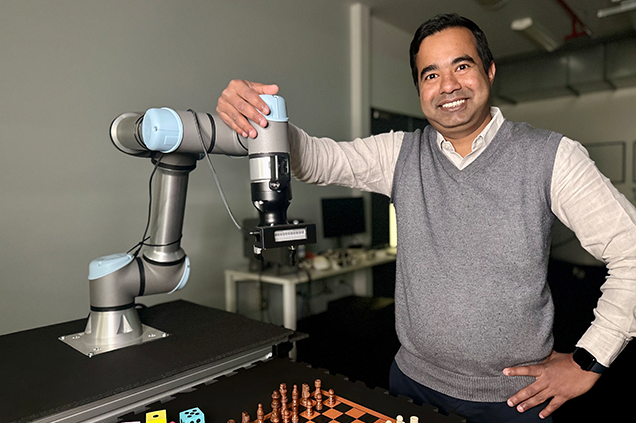
Associate Professor Santu Rana from Deakin’s Applied Artificial Intelligence Institute (A2I2) is a leading researcher of reinforcement learning in the robotics field.
‘I grew up in India where it’s common for workers to die due to dangerous working conditions. I’m inspired to design reliable robots – robots that can perform dangerous tasks instead of humans,’ Associate Professor Ranu says.
Employing reinforcement learning principles, he focuses on programming robots to process and respond more like humans and adapt to evolving environments.
‘Reinforcement learning is a method based on trial and error, allowing robotic systems to learn from their environments,’ Associate Professor Rana says.
‘It’s an approach that mirrors how humans learn. For instance, when we learn to ride a bike, we don’t follow a list of rules; instead, we try, fail, and try again until we get it right. Similarly, robots can engage in this process to master complex tasks.’
Associate Professor Rana explains that the current generation of robots lack understanding of the physics of our world. So, a robot trained to ride a bike on Earth would fail on Mars due to the difference in gravity.
His research focuses on integrating a physical model of the world into the robotic mind, enabling robots to adjust their actions based on environmental changes.
This activates robots to adapt and thrive, navigating new terrains and the irregularities of the natural world.
Using AI to detect and prevent falls
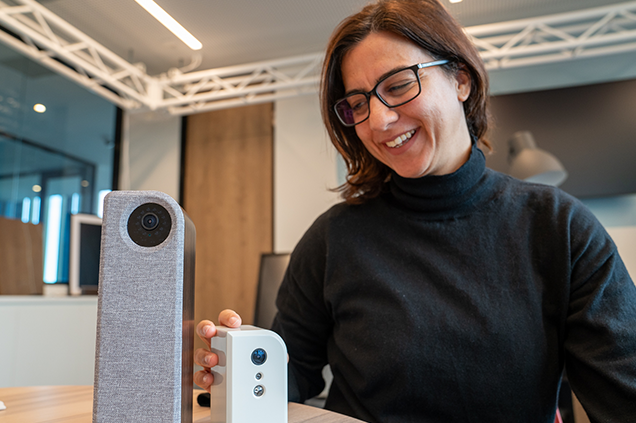
Another A2I2 researcher making an impact in the robotics space is Senior Research Fellow Dr Rena Logothetis. She is Deakin’s lead investigator on the HomeGuardian partnership project.
Dr Logothetis is working with HomeGuardian, a company which designs and markets fall alarm products, to enhance the effectiveness of its fall detector device using AI technology.
‘Falls are the leading cause of serious injury and injury-related death in Australia,’ Dr Logothetis says.
‘Treatment for falls costs the Federal government around $4 billion each year so it’s an important area of research.’
The primary practice for managing falls and fall risk is currently reactive. But this is something Dr Logothetis is hoping to change.
‘I’m working closely with HomeGuardian to improve an existing device to predict a fall or near fall. This will help preventative actions to reduce the incidence of a fall occurring.’
Dr Logothetis is passionate about the impact robotic and AI innovations can have and the power of collaborating with industry to solve real-life issues.
'It’s important to listen to the people who have the problem and understand the problem in depth. There is no social value in innovation when it does not solve a problem.’
Transforming centrifuge systems for aircrew training
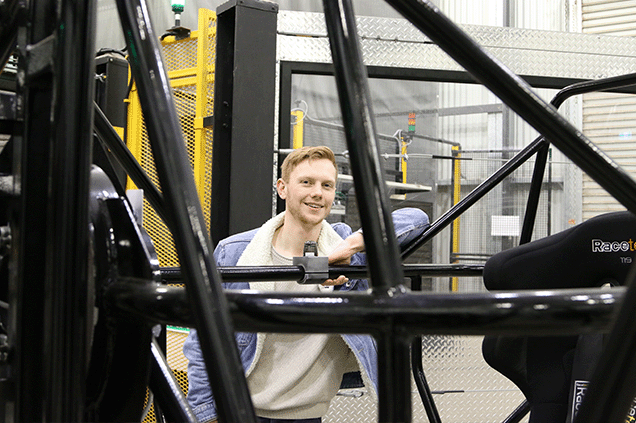
Associate Research Fellow Asher Winter from the Institute for Intelligent Systems Research and Innovation (IISRI) is exploring how to improve human centrifuge systems (HCSs) used in aircrew training. IISRI designed and built Australia’s first centrifuge ‘CYCLONE’ and Mr Winter’s design could be another national first.
‘HCSs are large robotic motion simulators designed to generate multi-axis gravitational accelerations on the user,’ Mr Winter says.
‘They provide the Airforce with a safe, consistent and cost-effective way to train aircrew for the extreme G-accelerations generated during fighter jet motion.’
Centrifuges typically consist of an eight-metre arm with a cockpit-style gondola attached to the end. The user sits in the gondola and the centrifuge system rotates the robotic arm to generate G-acceleration.
Centrifuge design and research has largely focused on generating a Gz (head-to-foot) acceleration with little consideration of G-accelerations along the x and y axes: a design that does not accurately reflect the entire environment of the aircraft or experience of the jet pilot.
This is what Mr Winter's invention is attempting to address.
‘To provide comprehensive and relevant training, centrifuges need to accurately recreate the G-accelerations of aircraft and mitigate negative motion effects on the human body such as vertigo and disorientation,’ Mr Winter says.
'Through my research, I've designed a four-axis centrifuge that meets these challenges.’
While the design is still in the development phase there has already been industry interest.
‘Australia currently sends aircrew to Malaysia to use the Royal Malaysian Airforce centrifuge for G-acceleration training,’ Mr Winter says.
‘Once all aspects of the design and operation of my centrifuge have been developed to the standards of Australian Defence
Force, my device could become its centrifuge system for aircrew training, medical research and structure performance evaluation, providing accurate simulation of aircraft motion with minimised negative motion effects.’
Robotic innovations in the RIoT Lab
Deakin’s RIoT Lab in the School of Information and Technology is an experiential learning space where researchers and students collaborate and explore robotics.
Two current students are investigating how robotics could improve people's lives and their design concepts are attention-grabbing.
Paul Phan's ‘Robotic Dog’ project aims to transform the Unitree GO 2 robot into a robotic guide dog to assist vision impaired people.
‘Our robot is equipped with advanced hardware, including multiple wide-angle cameras on the front and sides and a 2D Lidar sensor,’ says Mr Phan.
‘These components enable the robot to perform vision tasks essential for navigating complex real-world environments.’
Mr Phan’s prototype robot is designed to detect crosswalks and traffic lights with the aim of helping users to safely cross streets.
The 2D Lidar sensor enhances the robot's ability to detect obstacles in its surroundings, alerting the user to potential hazards.
While making a robot perform like a guide dog presents challenges, Mr Phan’s goal is to advance its ability to provide safe and reliable assistance for visually impaired individuals.
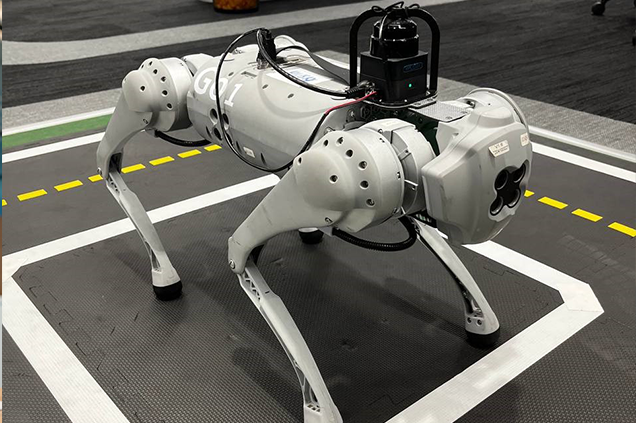
Another IT student, Thomas Koutsaplis, is examining how humans prefer to interact with robots.
His ‘Handover project’ focuses on the factors that influence a person’s interaction with robots including the movements and sounds the robotic system makes.
‘My research could assist people by making human-robot interactions more useful, comfortable and seamless,’ Mr Koutsaplis says.
‘If someone has limited motor skills, a robotic system could help them handle objects that they might not be able to reach or hold on their own. Connected to this, they might prefer how that object is passed to them - overhand or underhand. This is what my research is exploring.’
Mr Koutsaplis’ research involves testing three objects - a ball and two rectangular shapes – which are handed to a user by three different effectors: a vacuum gripper, a robotic hand and a parallel gripper. After each handover, the participant is surveyed about their experience to assess how comfortable and natural each handover felt.
‘When people hand objects to each other, a lot of information about the handover is determined by the object itself,’ Mr Koutsaplis says.
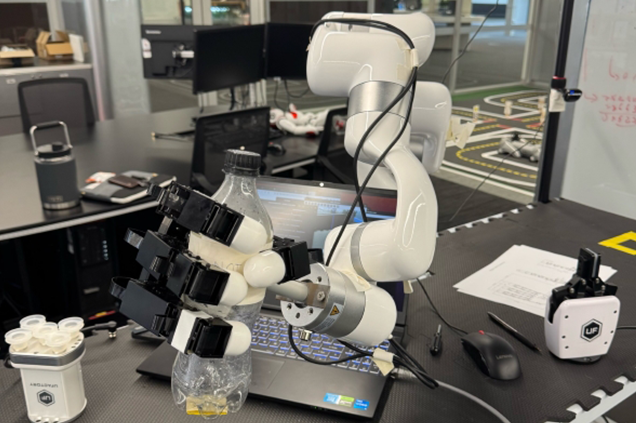
Want to know more about robotics and AI at Deakin?
The Applied Artificial Intelligence Institute (A2I2) is a top Australian research body focusing on human-centred AI. The Institute real-world problems using methods grounded in modern machine learning, deep learning and software engineering practices to make discoveries to advance knowledge and build systems that benefit society. Find out more about A2I2.
The Institute for Intelligent Systems Research and Innovation (IISRI) is home to Australia's largest research team in systems modelling and simulation, providing practical solutions and commercial-ready products for aerospace, rail, automotive, defence, security and health sectors. Find out more about IISRI.
The Robotics and Internet of Things (RIoT) Lab is a purpose-built studio environment designed to support collaboration and innovation located at Deakin’s Melbourne Burwood Campus. Find out more about the RIoT Lab.
The text of this article is licensed under the Creative Commons Attribution (CC BY) 4.0 International license. We'd love for you to share it, so feel free! Please note that images, videos, graphics and logos are not covered by the CC BY license and may not be used without permission from Deakin University or their respective copyright holder. If you have any questions, please contact researchcomms@deakin.edu.au.
Thanks for reading! You can find more stories like this at deakin.edu.au/research/research-news-and-publications. We ask that Deakin University and individuals are appropriately credited and that you include links back to this website. Quotes in this article can be extracted for other articles provided individuals are appropriately credited and you include a link back to the article URL.
Share this story
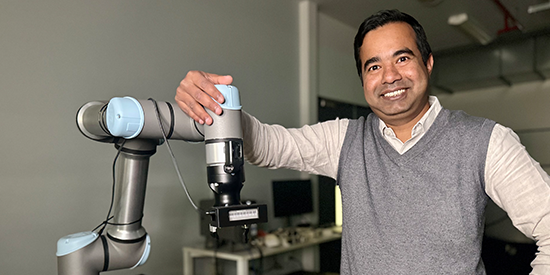
Key Fact
To mark National Science Week 2024, Australia’s annual celebration of science and technology, we’ve unearthed a few of Deakin’s coolest projects in the realm of robotics.
